
May 29 - June 5 live war map: Russian offensive slows, Ukraine prepares Crimea blockade
This week brings Ukraine two pieces of good news at once: permission to strike Russian territory with American weapons and the supply of AWACS long-range reconnaissance aircraft, crucial in establishing F-16 dominance over the front line
Ukrainian forces set records
May became the deadliest month for Russian troops. Despite the continued advancement of the Russian Air Force, Ukrainian soldiers received more weapons, resulting in four records. Firstly, 37,800 Russian soldiers have been eliminated. This number is significant, marking the first time since the war began that Ukraine has destroyed more in a month than Russia can currently mobilize. The trend continued in June. If nothing changes,Russia will not only lose the capacity to attack, but significant holes may appear in its defense. While a general mobilization in Russia could potentially change this situation, Putin fears its unpredictable consequences.
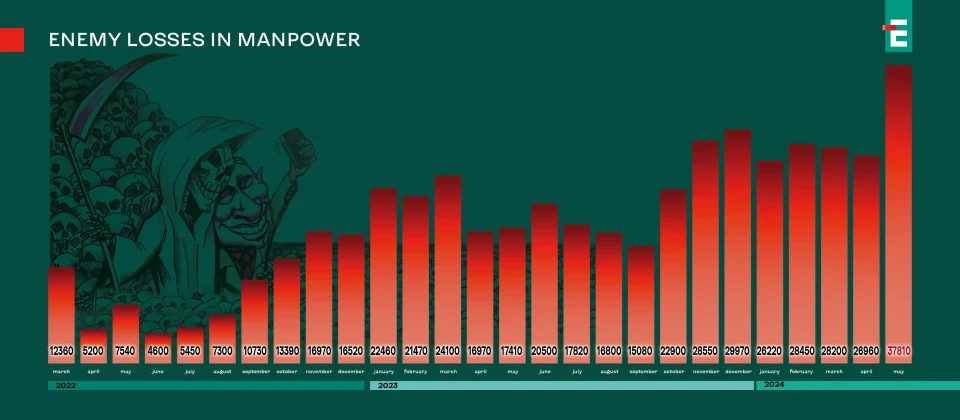
The mass destruction of Russian artillery appears as follows: 1,116 units have been eliminated. The Russians are losing the counter-battery fight. Even if they possess more shells, they will soon lack artillery to fire from, as Ukraine destroyed about 1,000 pieces in March and April.
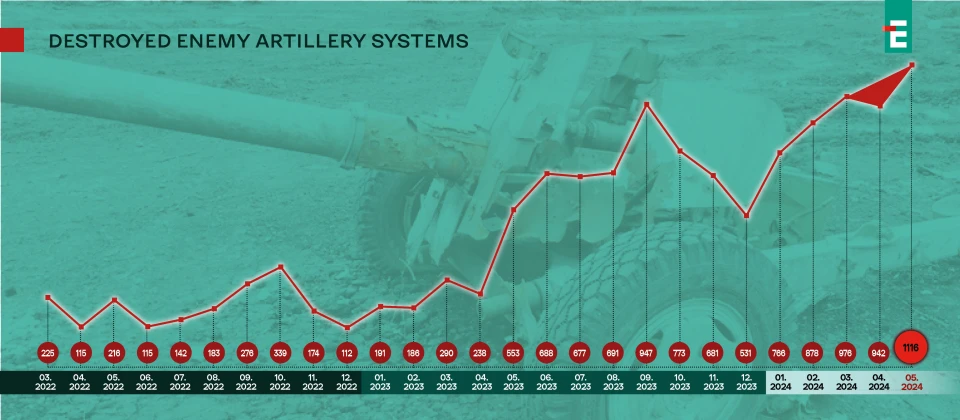
Additionally, 1,730 Russian vehicles were destroyed. This significant number is caused by Russia's shortage of armored vehicles, leading them to utilize whatever assets they can. Ukraine destroyed 868 armored vehicles and 416 tanks, marking the second-highest results for the war. These figures hold critical importance because Russian equipment stocks are not infinite. At the current destruction rate, their supplies will last approximately a year, and accelerating this rate brings Russia's defeat closer.
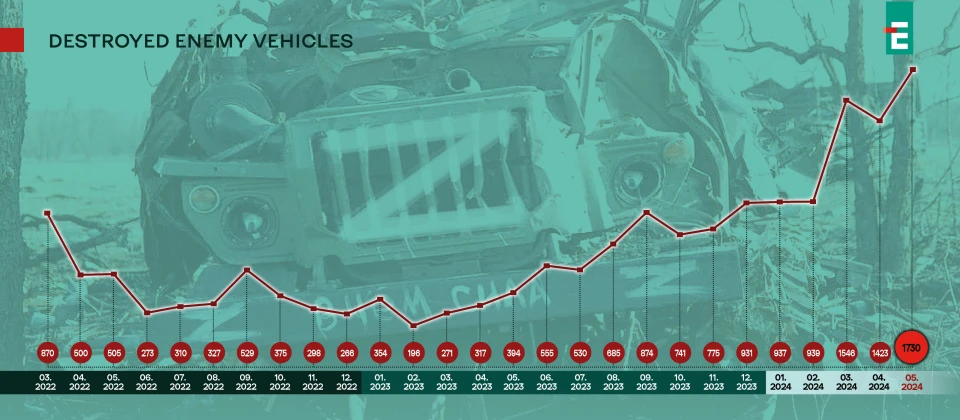
Another record – 1,049 downed operational-tactical drones – shows the Ukrainian Armed Forces are performing well. Of the 349 Shahed drones launched by Russia in May, only 10 reached their targets.
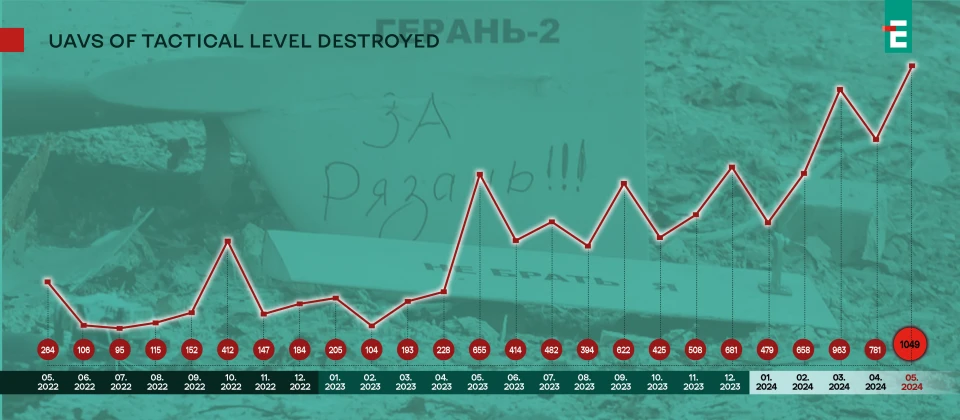
Unsurprisingly, the Russian offensive has stalled along almost the entire front line, with only minor gains in the Pokrovsk direction.
Kharkiv region frontline
The front line in the northern part of the region has barely moved. Russian troops still can't cross the Vovcha River near Vovchansk, either east or west. They tried hardest near the villages of Buhruvatka and Starytsia, but failed to flank the Ukrainian Defense Forces. In Vovchansk itself, Ukraine regained several streets in the city's center, took better positions, and continued pushing Russian forces out. Here, the Ukrainian military captured over 60 prisoners at once and eliminated many more. Despite this, the Russian Air Force hasn't given up on their offensive towards Kharkiv and has sent reinforcements. They aim to force the river and link their two bridgeheads, connecting the front near Vovchansk with the group near Lyptsi, where they've been stalled for weeks. There are rumors of an attack on the Sumy region, but it's unclear with what resources. Any new campaign there will likely involve smaller forces than in the Kharkiv region.
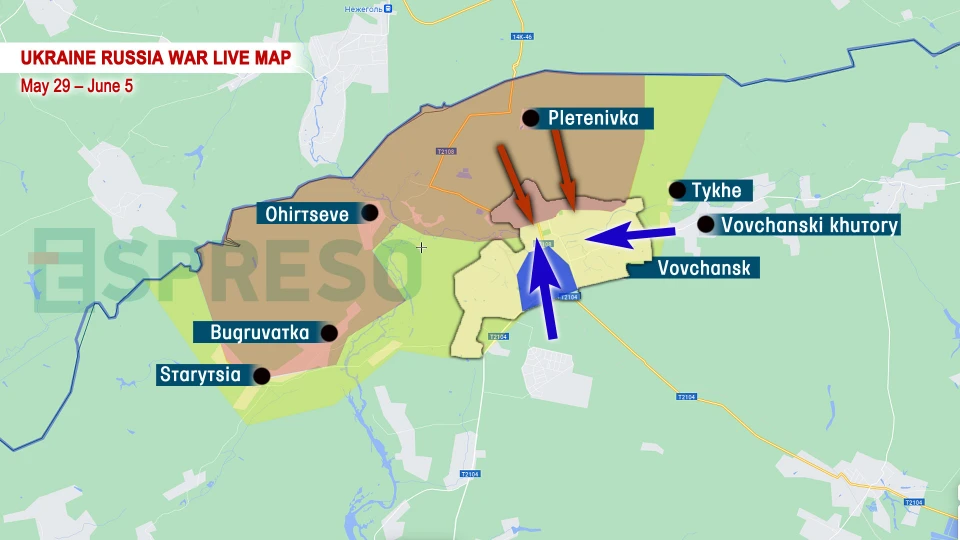
Meanwhile, Ukrainian drones destroyed a convoy of armored vehicles heading towards Ukraine in the Kursk region. Additionally, for the first time, American HIMARS struck the Belgorod region, destroying S-300 installations that had been shelling Kharkiv. Now, the Russians will have to move their anti-aircraft systems further back, which should reduce attacks on Kharkiv.
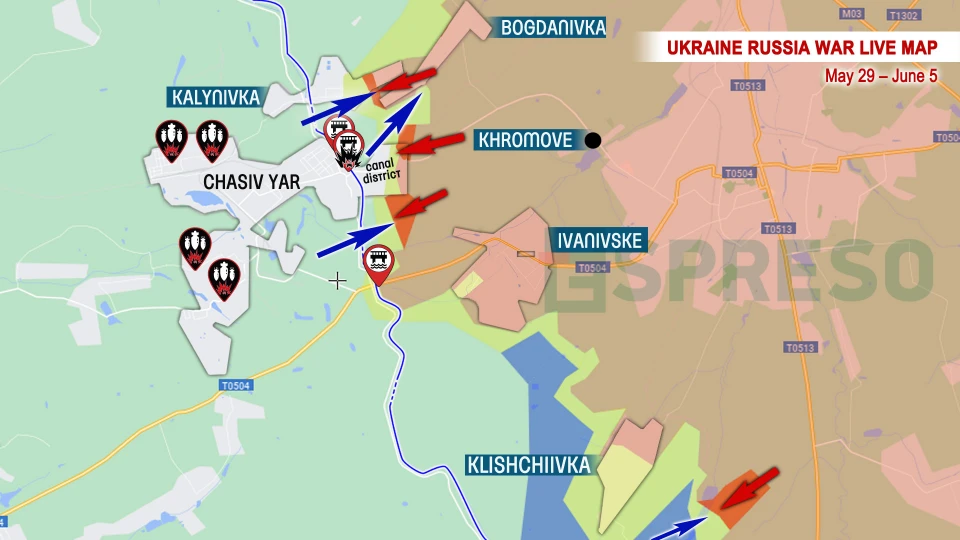
Creeping attack on Chasiv Yar
The city remains a top priority for Russia, so they're sparing no resources. Aircraft drop bombs on Ukrainian defenders dozens of times a day. On the northern flank, Russia is desperately trying to break through to Kalynivka and reach the Siverskyi Donets-Donbas canal. One assault reached the outskirts of the village, but the Ukrainian Armed Forces repelled the attack and even took several enemy positions southwest of Bohdanivka.
In the center, the Russians have moved close to the southern outskirts of the Kanal district and are trying to secure the first houses. They're also advancing along the railway and towards the houses on the northern edges of the district, always charging head-on. Fierce urban battles are expected here soon. On the southern flank, Russia failed to secure positions on the other side of the channel but hasn't given up. They still aim to dislodge Ukrainian forces from Klishchiivka and Andriivka. For now, the Ukrainian Defense Forces are holding their ground.
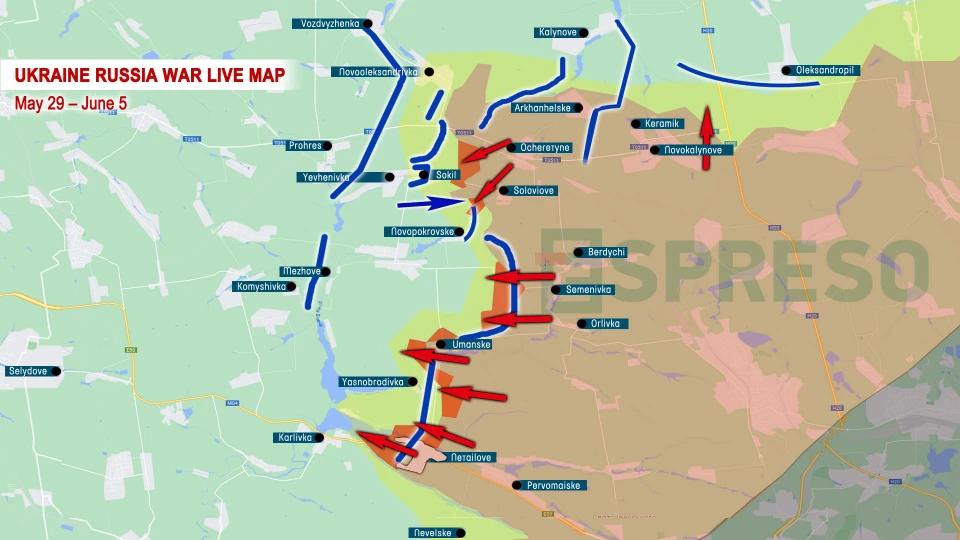
Post-Avdiivka front remains most dynamic
The width of the front line allows Russian troops to constantly shift the focus of their attacks and ensure advancement. The front line is unstable, and Ukrainian forces haven't retreated to their main defenses. This week, the Russians targeted west and south of Solovyove, attempting to storm Sokil and Novopokrovske. The front line moved about 800 meters west. In Semenivka, the Russians leveled the front line and advanced 1.5 km. They pushed 2 km along the road to Selidove, nearing the Karlivka reservoir, where Ukraine’s defense line is. On the northern flank, they failed near Novooleksandrivka and Keramik. The most clashes occur in the Pokrovsk direction, where Russian troops suffer the greatest losses.
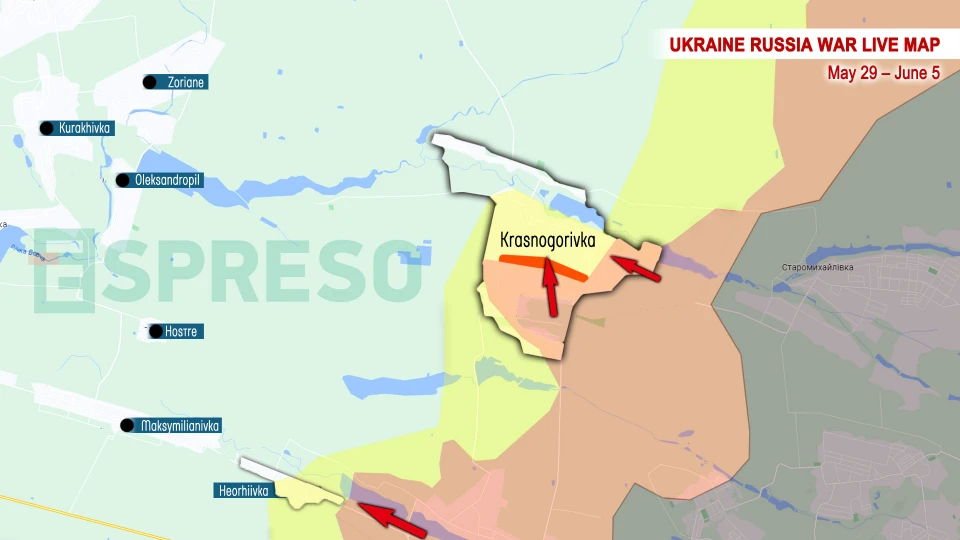
Battle for Krasnohorivka
Fierce battles are raging for Krasnohorivka due to its strategic importance for both sides. The Russians have taken several more blocks in the city's center. However, the Ukrainian Armed Forces still control 40% of the city, especially the densely built northern part, making it tough for the Russians to advance.
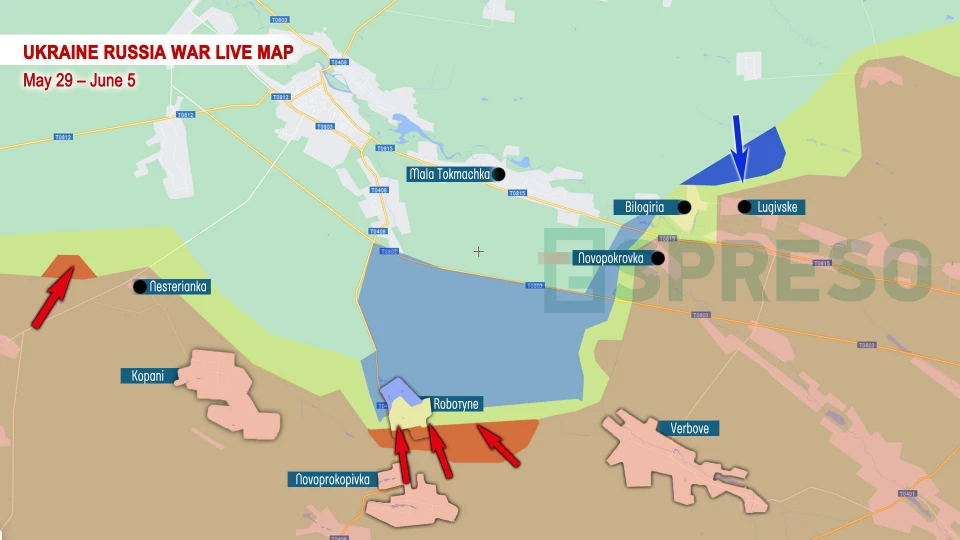
The Southern front come to alive again
In Robotyne, the situation remains dire. Russia has secured the central part of the former village, while the Ukrainian Armed Forces hold the northern outskirts. Russian troops have pushed 700-800 meters north of the main defense line between Robotyne and Verbove, which the Ukrainian Armed Forces had previously captured. In Staromayorske and Urozhaine, the front lines haven't changed significantly this week. The Russians hold most of Staromayorske but haven't progressed in Urozhaine, where they previously reached the southern outskirts.
Meanwhile, previously quiet sections of the front have "come to life." The Russians attacked north of Nesteryanka, capturing several Ukrainian positions. However, the Ukrainian Armed Forces took several positions near Luhivske, northeast of Robotyne, an area where last year's counteroffensive began. While it's too early to declare a major campaign, the front in the Zaporizhzhia region is expected to be more active this summer than in the past six months.
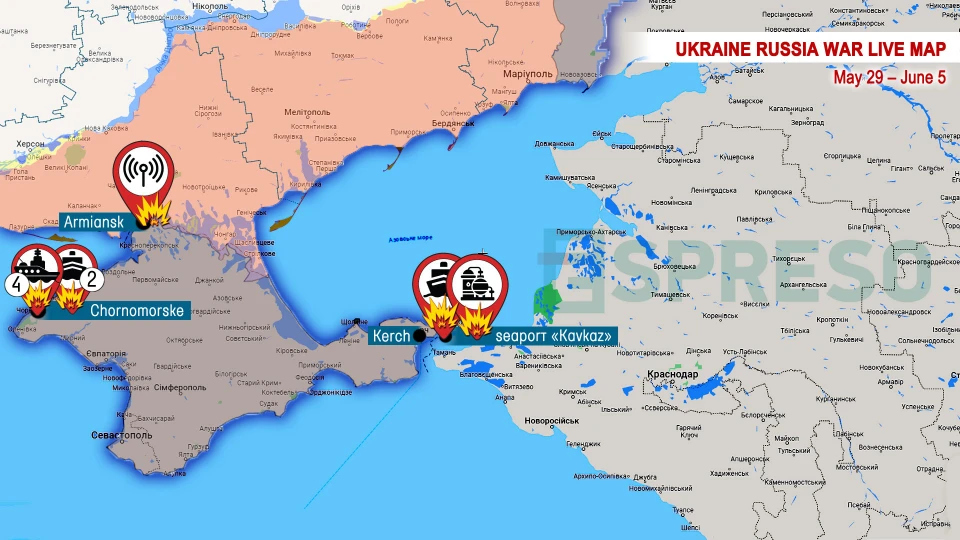
Crimean Bridge – get ready!
On May 30, eight Neptune missiles supported by naval drones hit Russian ships in Chornomorske Bay, destroying four military boats and two ferries. The next day, more missiles targeted ferries on the left bank of the Volny and Chushka crossings, as well as infrastructure in the port of Kavkaz. This ferry crossing was an alternative to the Kerch bridge, crucial for military transport. On June 4, the Ukrainian General Staff announced that the Ukrainian Armed Forces struck again at a ferry crossing in occupied Crimea and an oil terminal in Russia’s Krasnodar Territory.
Also on May 30, missiles destroyed the Russian Nebo-SVU radar near Armyansk in northern Crimea. This $100 million radar monitored a 380-kilometer section of the front. Clearing the Crimean sky ensures missiles can reach their targets. The Crimean Bridge might be next. The entire Crimean peninsula is now within the reach of the Ukrainian Armed Forces.
The maps were created using information from the General Staff of the Ukrainian Armed Forces and other verified sources. These maps are not highly accurate but reflect general trends in the war zone.
- News











































